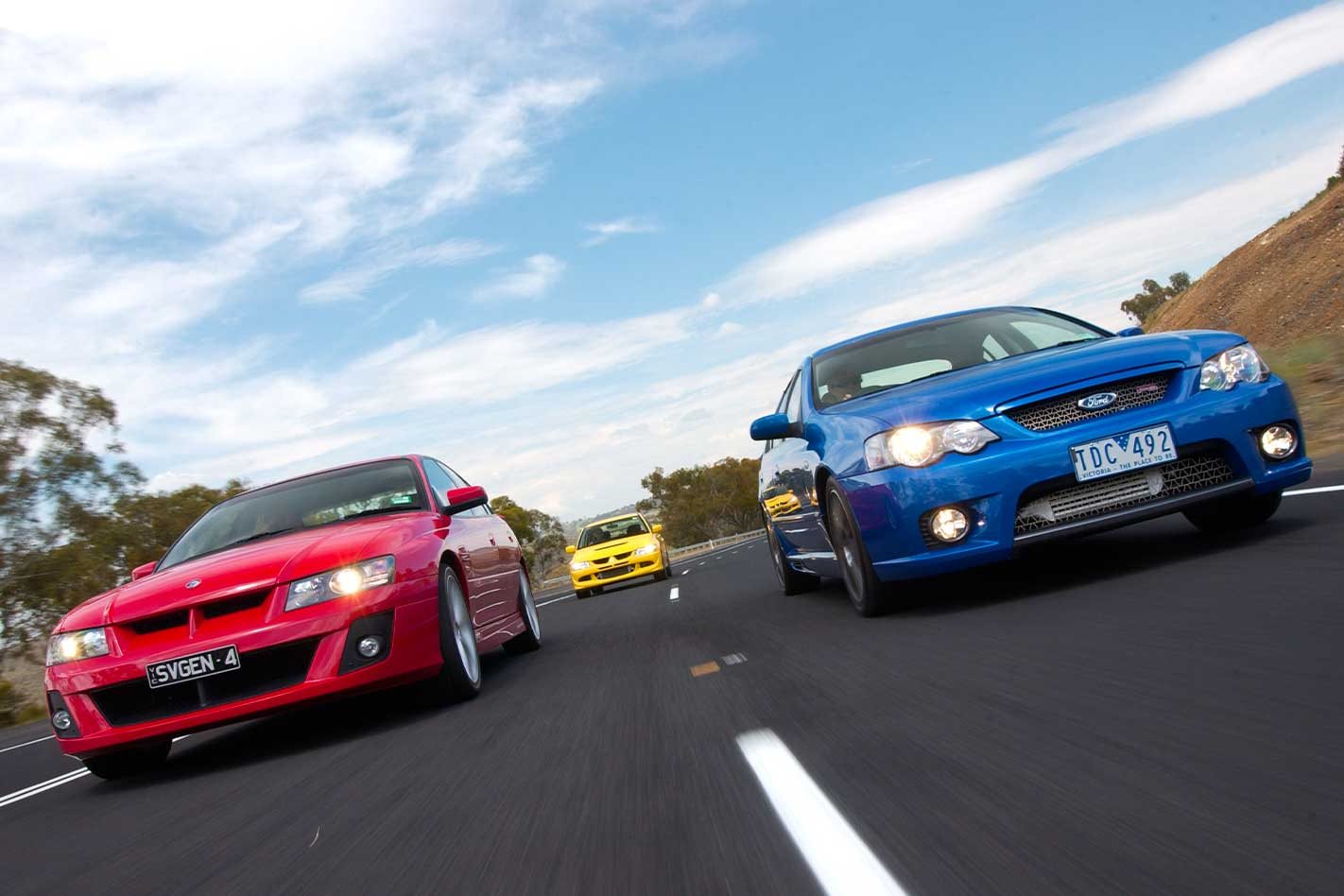Can’t beat cubes, sixes are for softies who can’t handle a V8 and only milk and juice come in two litres.
This feature was originally published in MOTOR’s February 2005 issue
Four, six or eight, it’s either born or bred. And we’re in such a golden era of performance road cars that small capacities, turbos and tricky technology can belt on the door of a big-banger V8.
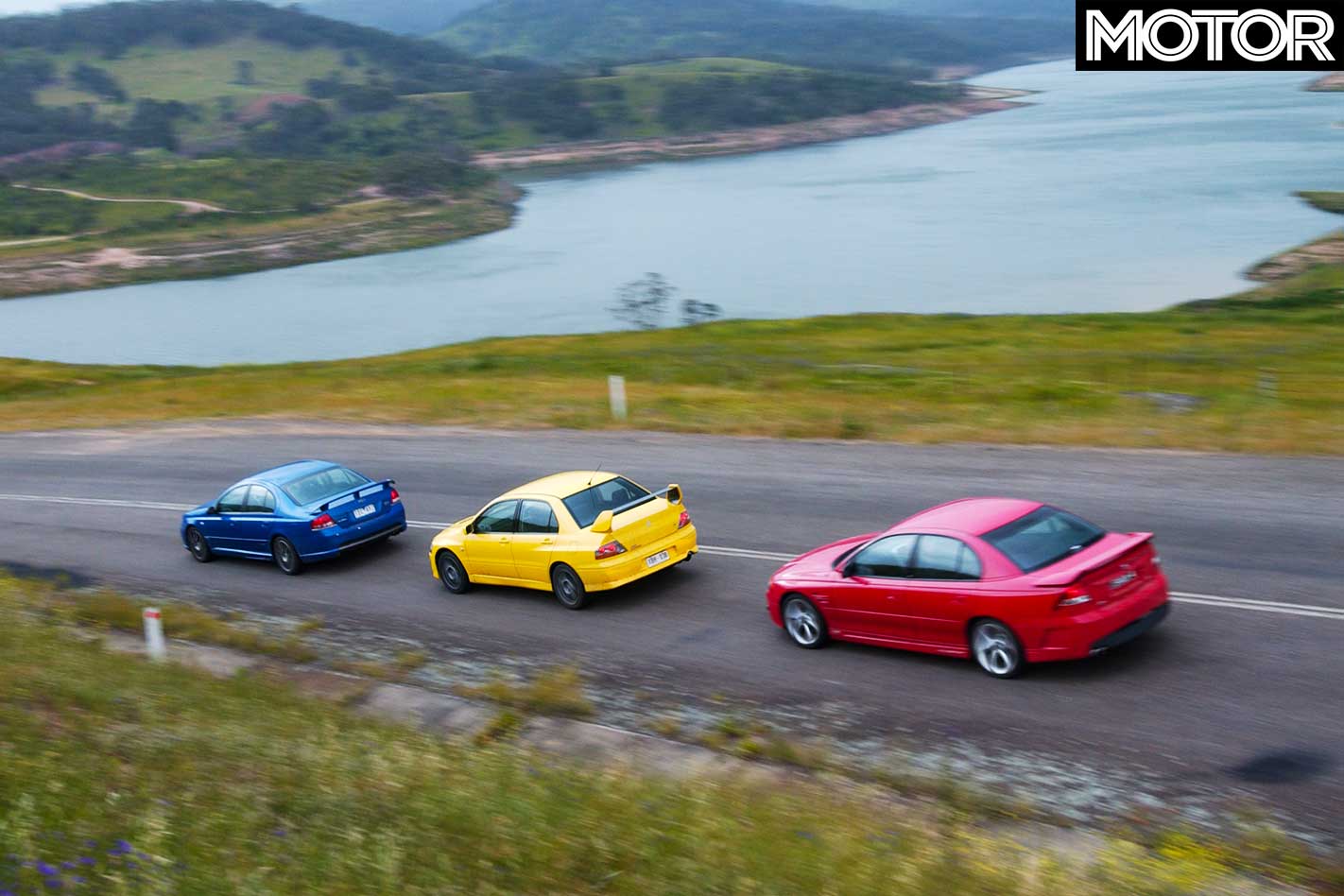
Each contender is the current king of its crop: Mitsubishi’s Lancer Evolution VIII, FPV’s F6 Typhoon and HSV’s ClubSport. Two-litre versus four-litre versus six-litre, numerically neat in capacity and price. At $59,850, the FPV is the bargain of the group, the ClubSport is $2000 more, while the EVO adds another $140, making the current Bang For Your Bucks champ the most expensive here.
On paper, the Lancer’s not that impressive: more than 100kW down on the HSV, and, though, it’s 226kg lighter, it still has the weakest weight-to-power ratio. No, the EVO makes up for its four-cylinder deficiencies with tricky diffs channelling all-wheel drive through rubber that’s almost as wide as those on the big Aussies.
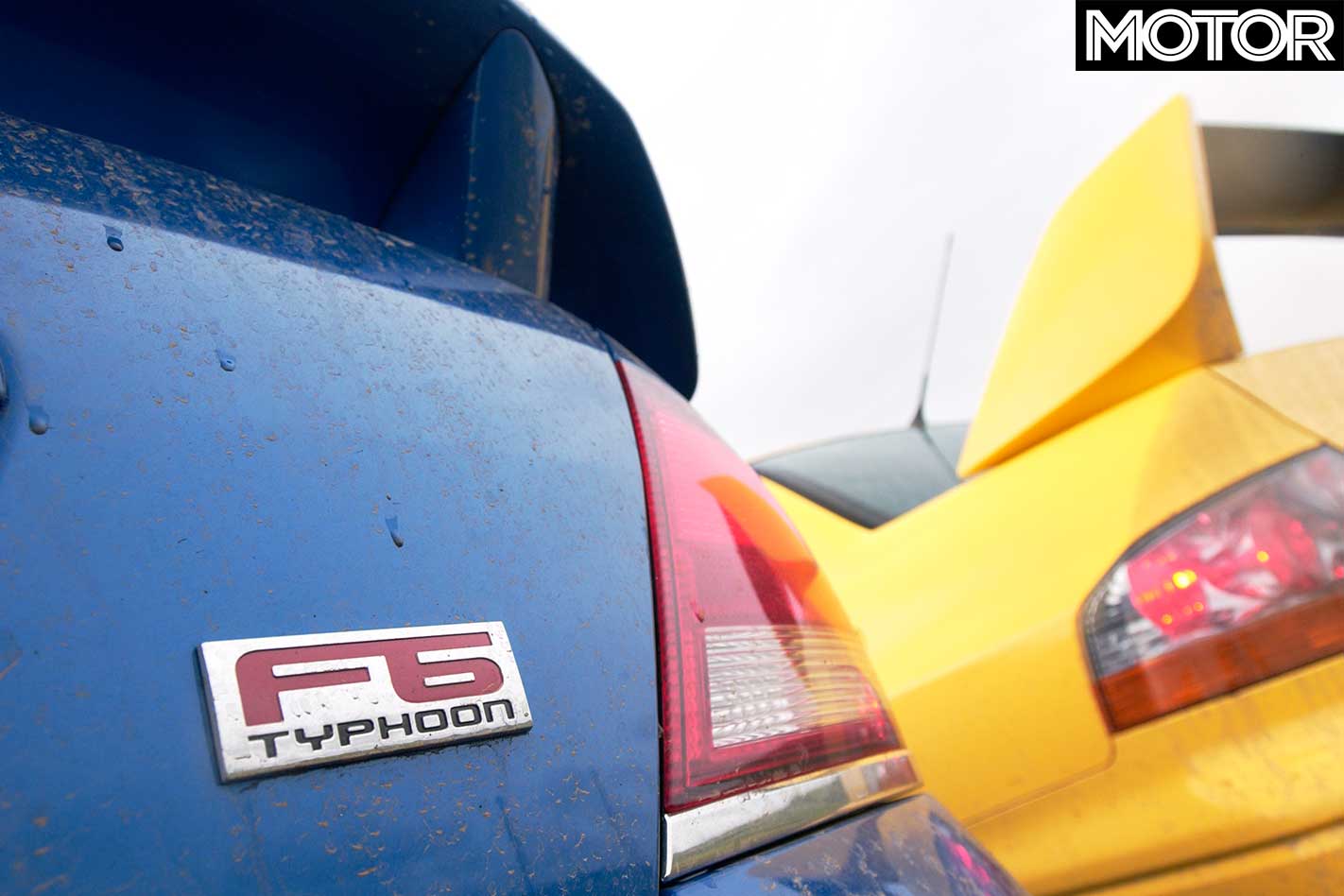
FPV’s F6 Typhoon sits in the middle ground with power. Over the donor XR6 Turbo, the more powerful, better-geared, torque-topping F6 should up the ante.
The HSV is the big daddy and the archetypal Aussie muscle car: biggest engine, most power, largest brakes, and the largest wheels – who needs the R8 spec?
Round 1 – Quarter-mile
Light weight, all-wheel drive and an ECU-limited 5000rpm launch rockets the EVO off the line: it gets to 100km/h in 5.4 seconds, 0.4 faster than the HSV and one second clear of the FPV. The Evolution passes the quarter-mile mark 0.8 seconds ahead of the Ford – and it’s still pulling away.
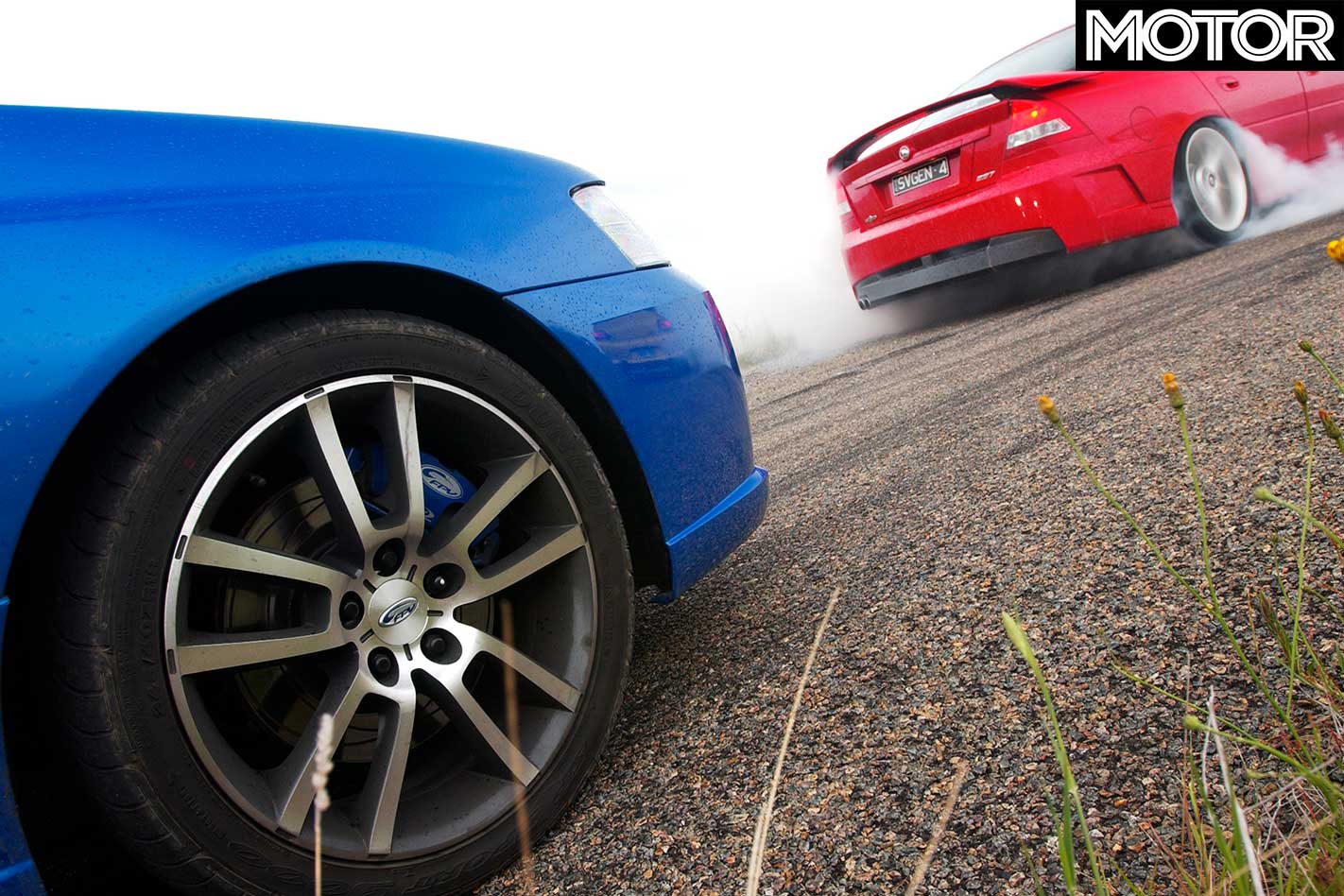
The Typhoon needs careful throttle modulation to balance between bogging and wheelspin. But the Typhoon’s figures aren’t super fast, making it the slowest of the group over the quarter by six-tenths.
The ClubSport loves the strip: dial up around 3500rpm, but launch revs aren’t too important because power and torque is everywhere. It takes until third gear to start reeling in the Mitsubishi and even though, at the quarter-mile finish line, it’s pulling 8km/h more, it’s still 0.2 behind.
Drags score: Evo VIII – 3 ClubSport – 2 Typhoon – 1
Round 2 – Street start
The rolling start is more real-world relevant, as it eliminates the Lancer’s all-wheel-drive jump.
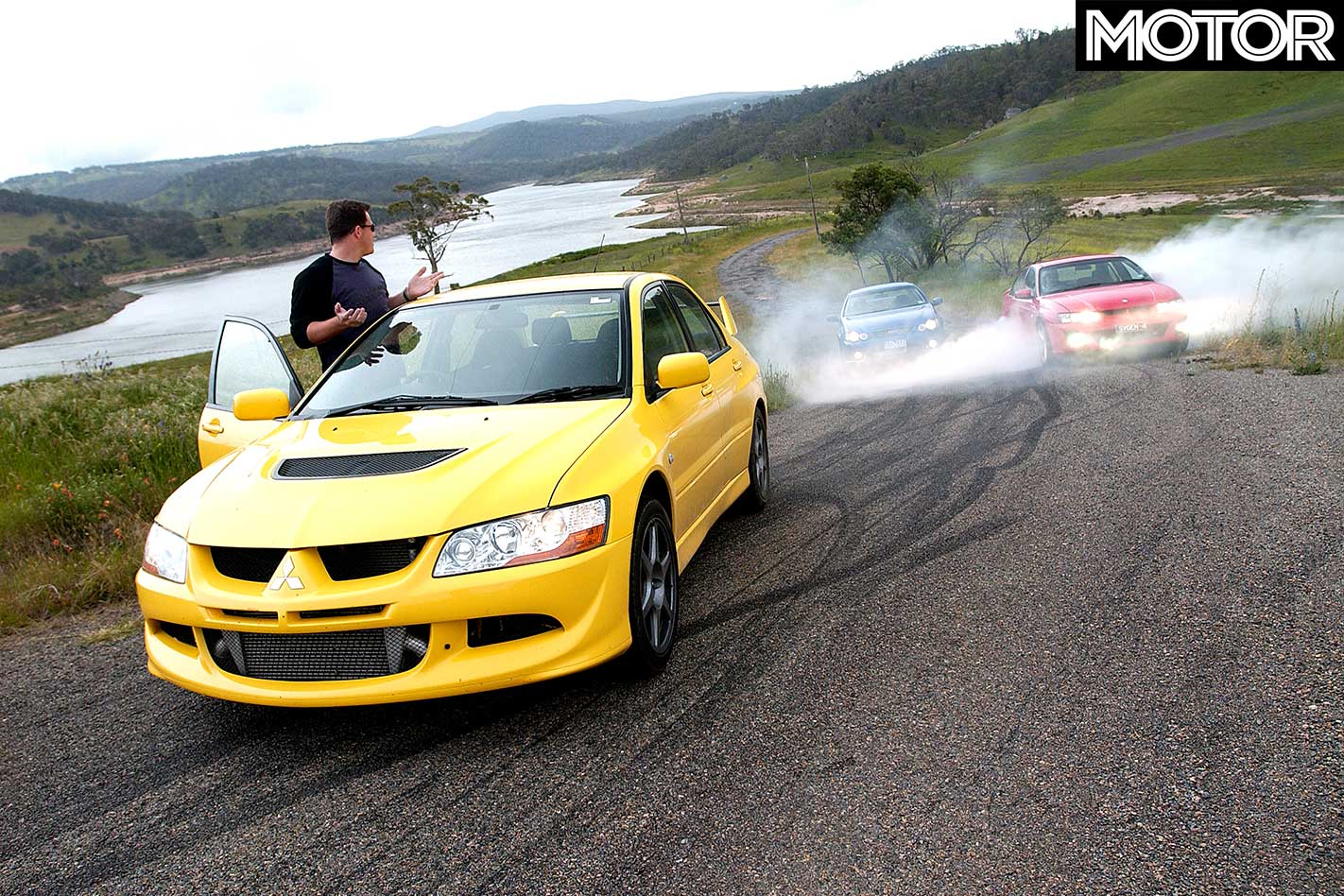
From 20km/h, the ClubSport’s instant response gets it half-a-car ahead, but once both turbos come on boost, they surge back. After first, second, third and fourth gear, there’s not even one car-length between all three with the Clubbie and EVO rubbing door-handles as the Typhoon starts to fade.
While the Typhoon’s peak mid-range is fractionally stronger than the Clubbie, it doesn’t carry its pace to redline. The whistle and choof of the turbo working at 9psi is there, and there’s urge from 2500rpm, but full boost takes until 4000rpm and by 5000rpm it’s losing both boost and breath. Gearing’s the main difference: in second gear, the Lancer does 104km/h, the Typhoon 106km/h, while the Clubbie reaches a high 116km/h.
How three so mechanically different engines and cars can produce such similar performance is remarkable and changes the rolling start order slightly.
Rolling-start score: ClubSport – 3 (tied) Evo VIII – 3 (tied) Typhoon – 2
Round 3 – Specs
It’s easy to see where the $60,000 goes in an EVO. As a purpose-built performance four-cylinder, the Evolution VIII’s money drips from the drivetrain and, err… not the interior.
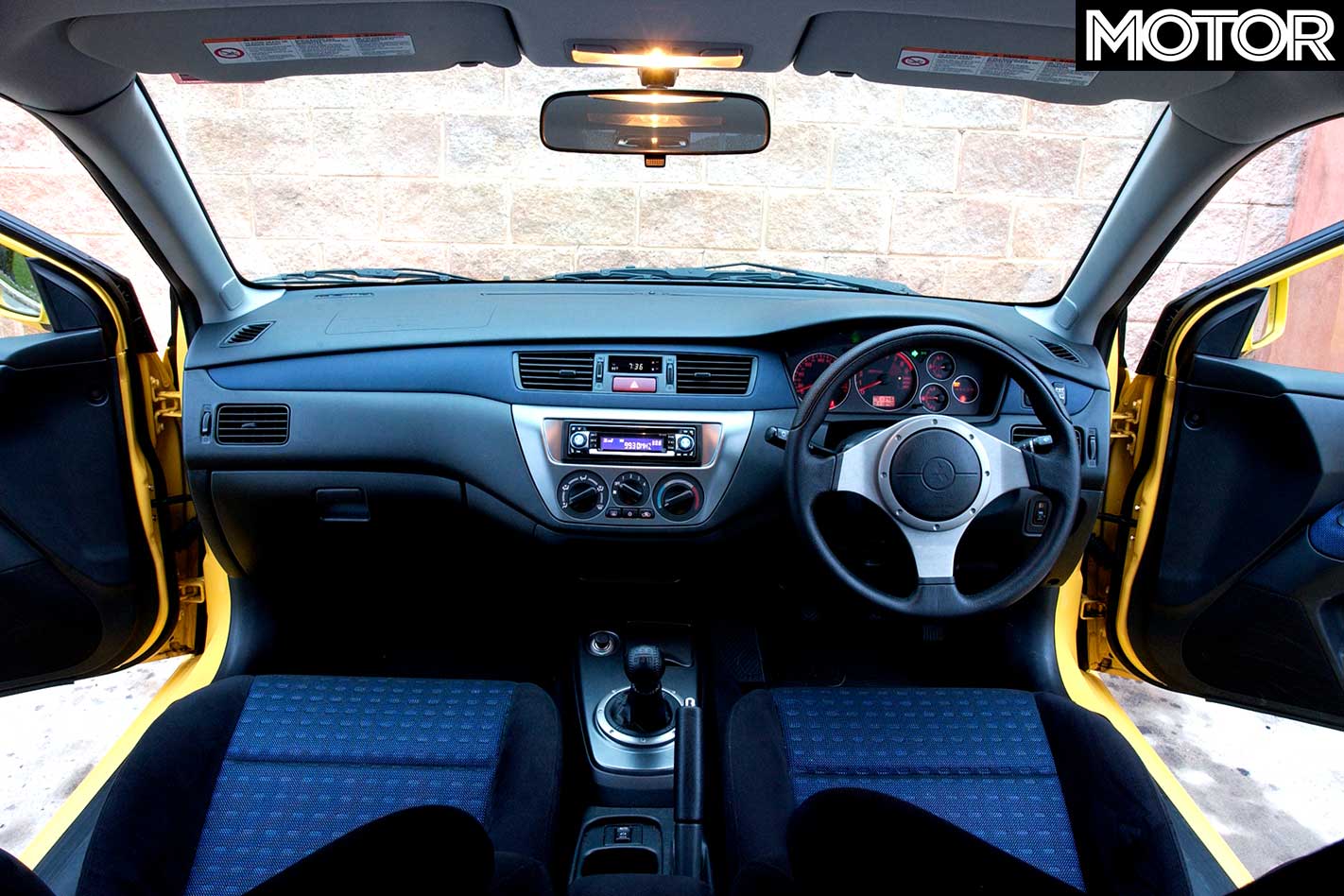
There are manual Recaro seats that hug like a bear, basic air-con and a single CD player. The only one lacking cruise control, it gets the modern basics of central locking, power windows, mirrors and steering. What’s lost in frills is gained in thrills: the diff control button and intercooler water spray are there for a reason.
The pedals are spot-on and the shifter’s like something from a Daytona machine: light, a little clunky but quick. There’s a 260km/h speedo, 7600rpm limiter, and despite the left-hand indicators, it’s superb.
On 17s, it has the smallest wheels here, but the EVO’s suspension and ride is as firm as the FPV’s on 18s and the HSV’s 19s. We’ll get to the trade-off in a moment.
If it weren’t for the small Typhoon plaque near the six-speed shifter, you’d be doing well to spot it as FPV’s hot six. The small boost gauge is the other clue, but without any numbered scaling, it’s largely pointless. As is that stupid start button that’s infected another car.
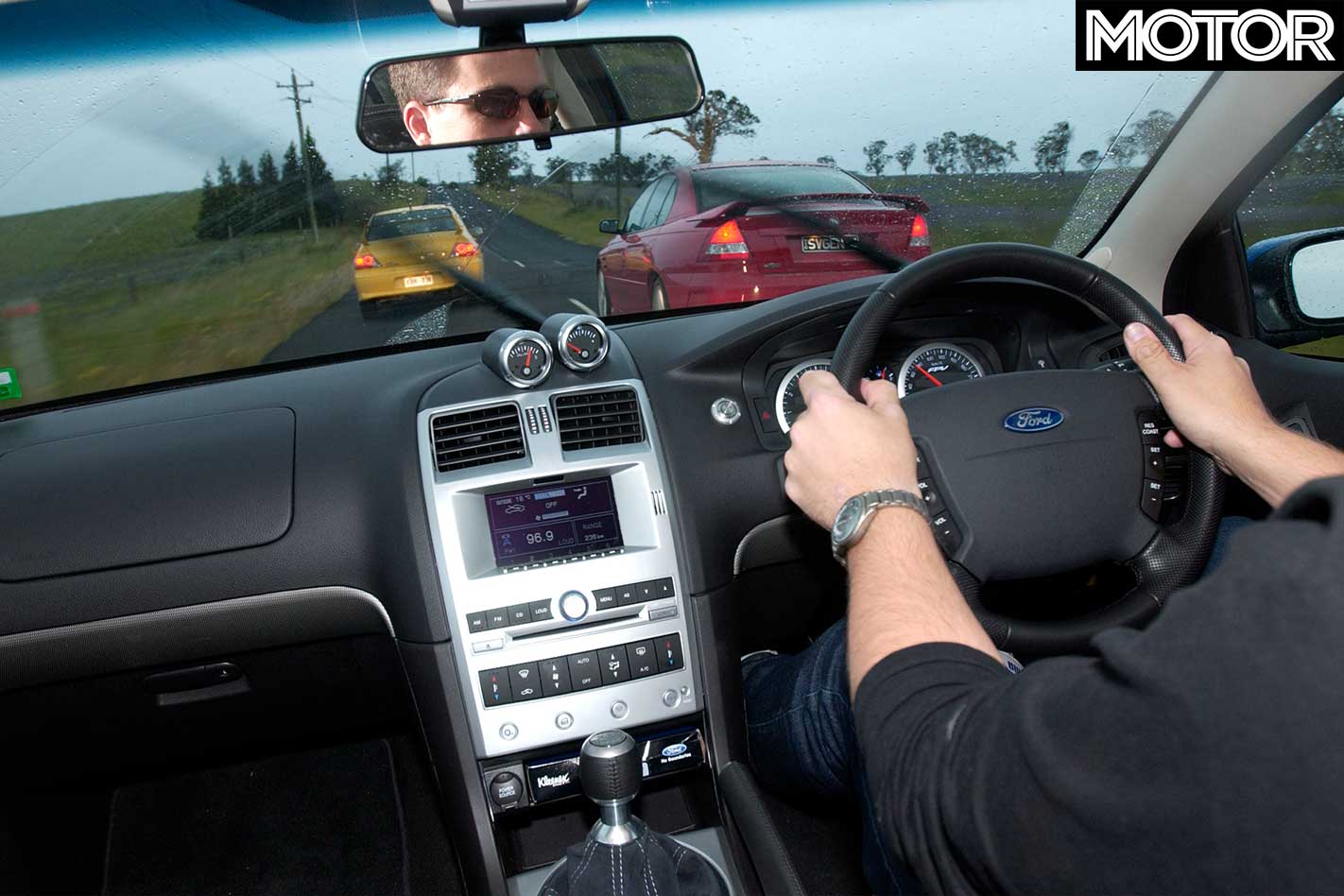
Some tips FPV: either develop a proximity key, or move the button to the right to make starting a one-handed operation and eliminate the spring-loaded ‘starting’ position from the key.
That aside, it’s all good inside the Typhoon. The alcantara-insert electric-height-adjustable seats get our vote with the best mix of support and comfort, while the extras include dual-zone climate control, auto headlights, trip computer, traction control and a central locking button: the latter lacking in Commodores.
There are stereo and cruise controls on the Ford’s steering wheel and while the shift action is marginally better than the HSV, it’s only noticeable back-to-back. The worst problem, though, is the clutch pedal: it sits higher than the brake and its friction point is awkwardly high, in the top few centimetres of pedal travel.
The speedo runs to 270km/h, and the 8000rpm tacho, still lacking a redline, is harsh-limited at 5900rpm, with an irritating chime around 5700rpm that can’t be silenced.
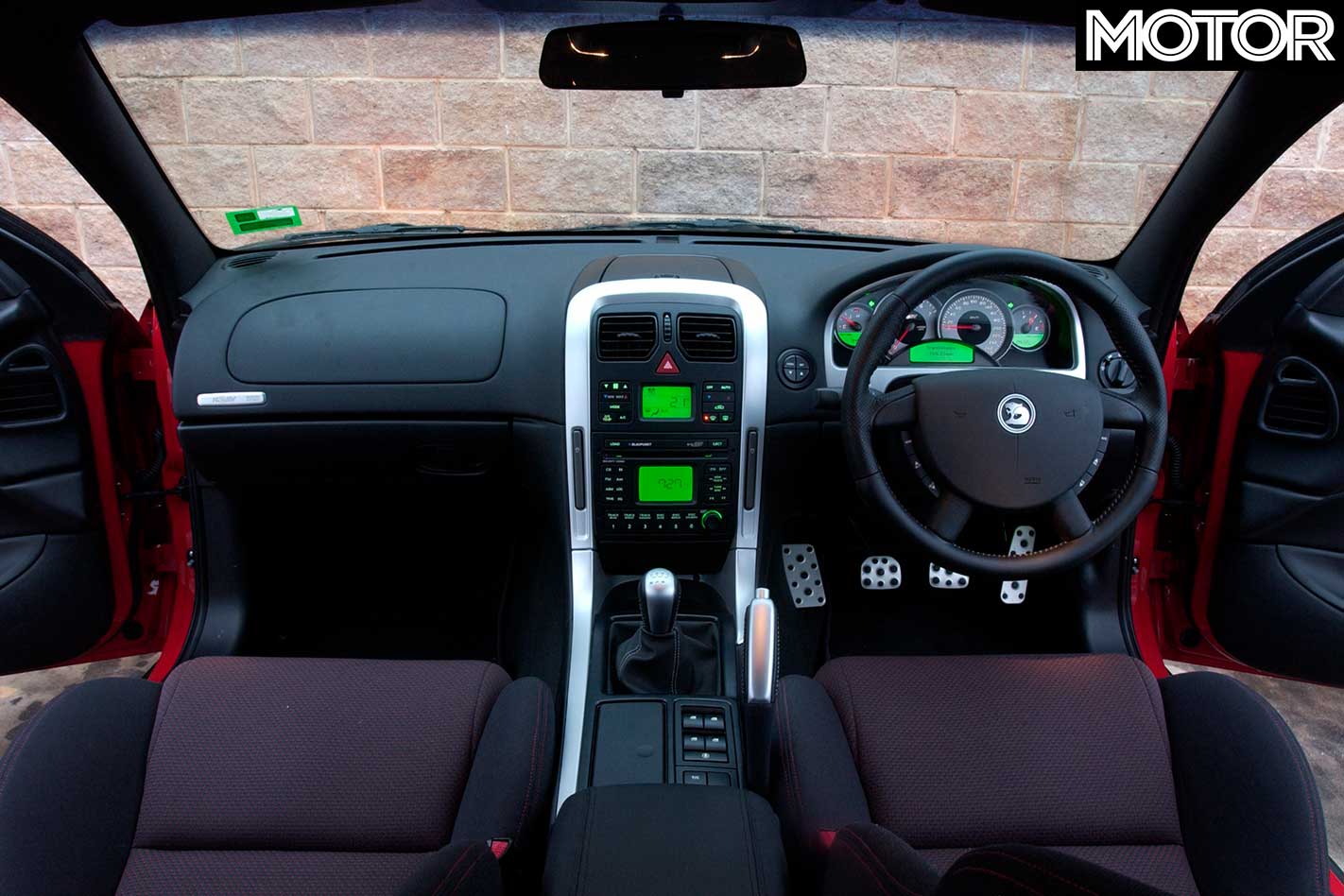
The ClubSport also has a chime but it’s not as loud. And with a 6600rpm limit on a seven-grand tacho, it sits alongside a 260km/h speedo. Electric height-adjustable seats are spongy and comfy. But they sit too high and don’t offer as much lateral support. And the steering wheel needs to be 10 percent smaller in diameter.
In addition to Typhoon’s equipment, the Clubbie adds… not much. Almost identical in spec, the only Z series identifier is the handy storage console atop the dash. How about an LS2 6.0-litre badge somewhere inside?
Interior score: Typhoon – 3 (tied) ClubSport – 3 (tied) Evo VIII – 1.
Round 4 – Hardware
All similar tough stuff here. Mitsubishi shows FPV how to do a front mounted intercooler. Yes, it may be silver, but Typhoon’s intercooler still looks undersized, offset and like it was pulled from another car.
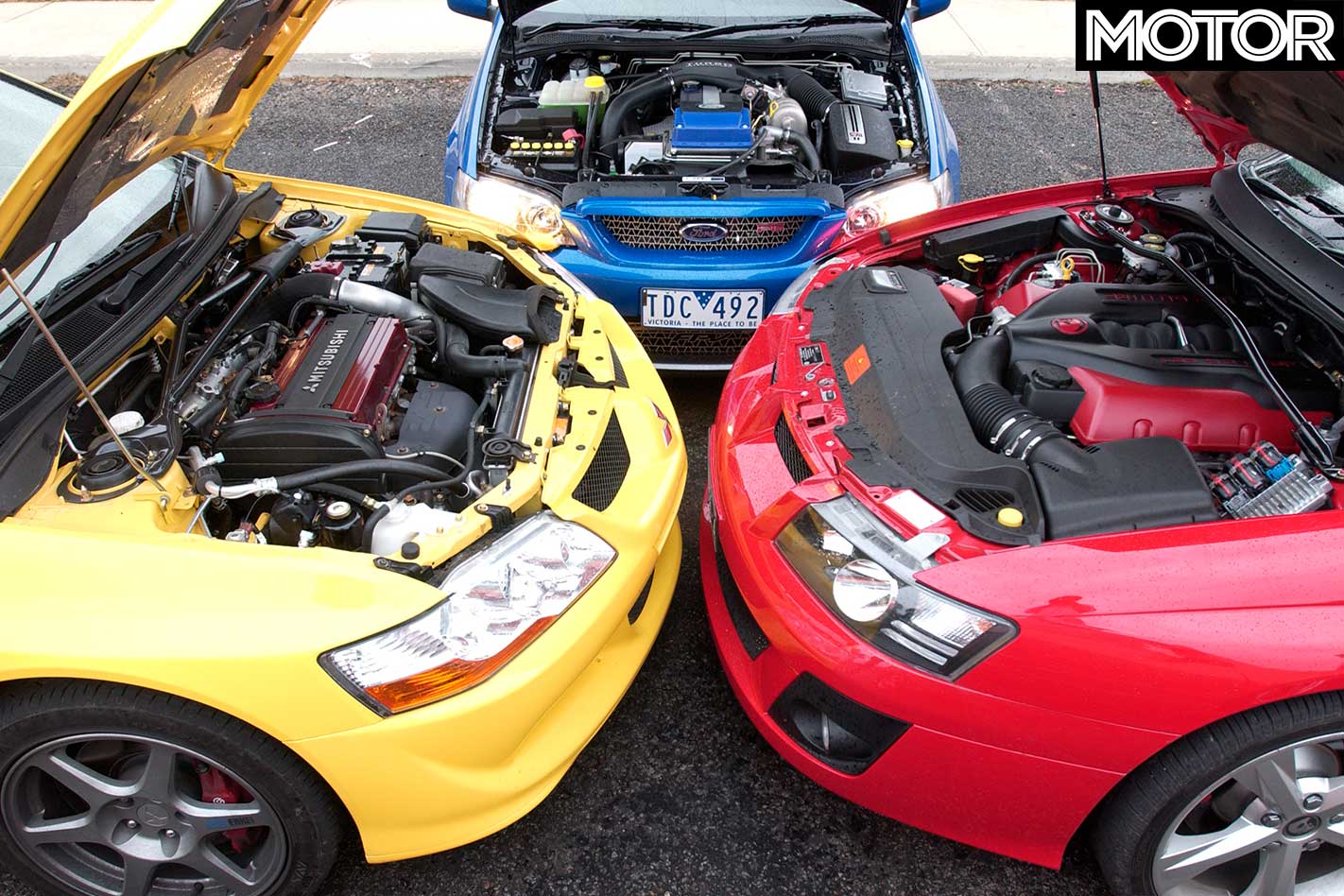
Brakes are similar in spec but offer different performance. The Evolution runs the smallest front rotors, but it’s the only one to carry Brembo four-piston calipers as standard and will cop a hammering.
They’re consistent, progressive, bullishly effective and with ABS and all-wheel drive, the most effective brake package here by far. But they’re not the best: the ClubSport’s set-up offer better progression, better feel and almost equal the Lancer’s stopping power, sinking the nose into the ground with the largest diameter rotors here, front and rear.
Around town they have better feel than the EVO, and when worked hard they remain surprisingly resistant to fade. Now can HSV please make the brake pedal closer to the throttle for easier heel-and-toe downshifts?
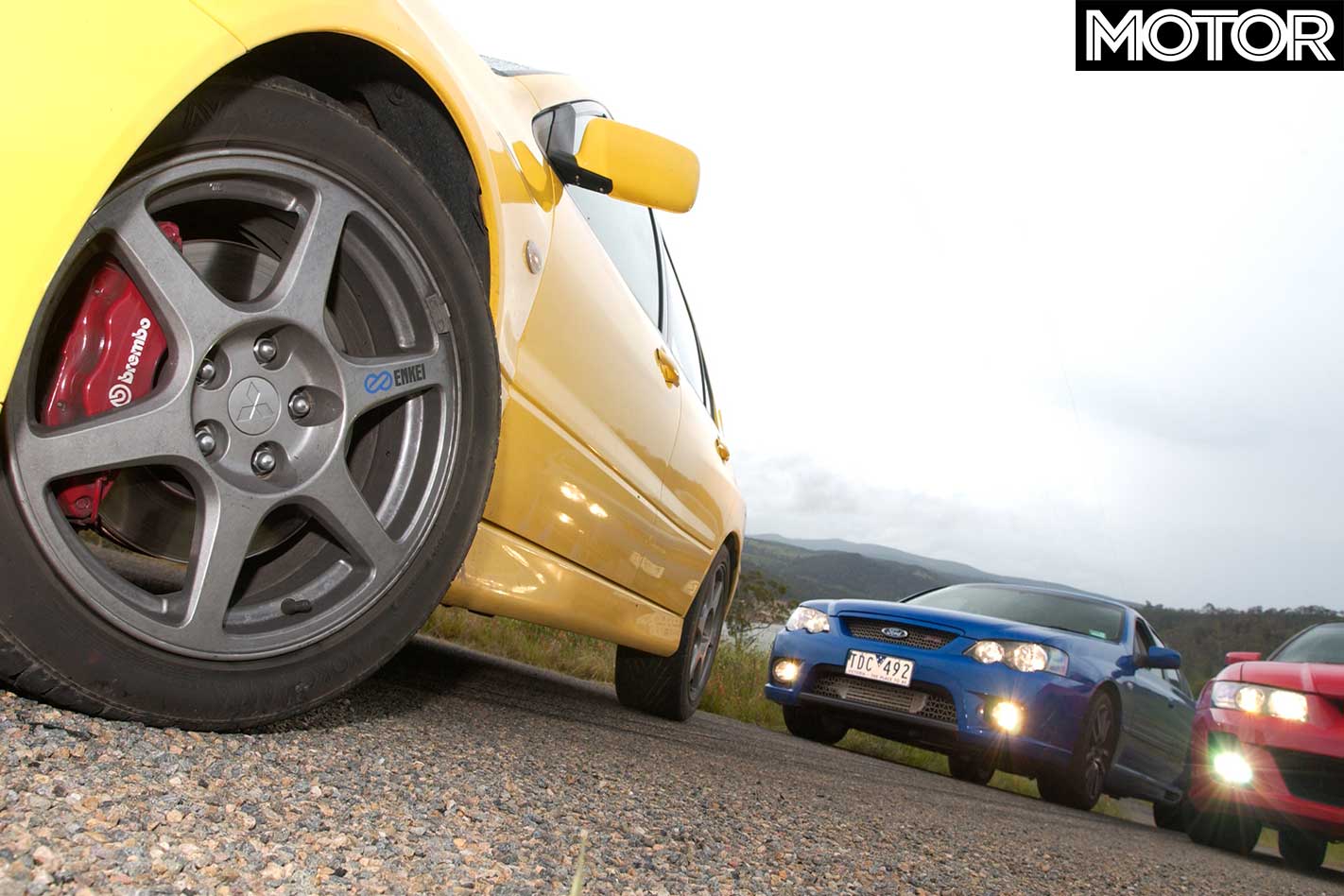
The Typhoon? Good. Very good. Its PBR calipers almost have the retardation of the HSV, but there’s not as much feel or progression and they vary with differing levels of vacuum. And they were the first to fade – 1715kg tends to do that. Don’t get us wrong, the F6’s standard brakes are very good, but in this company its weaknesses are exposed.
Equipment Score: Evo VIII – 3 (tied) ClubSport – 3 (tied) Typhoon – 2.
Round 5 – The mountain pass
A real road is possibly the most relevant test. The Z series ClubSport has good turn-in, and its chassis understeers less than VYs.
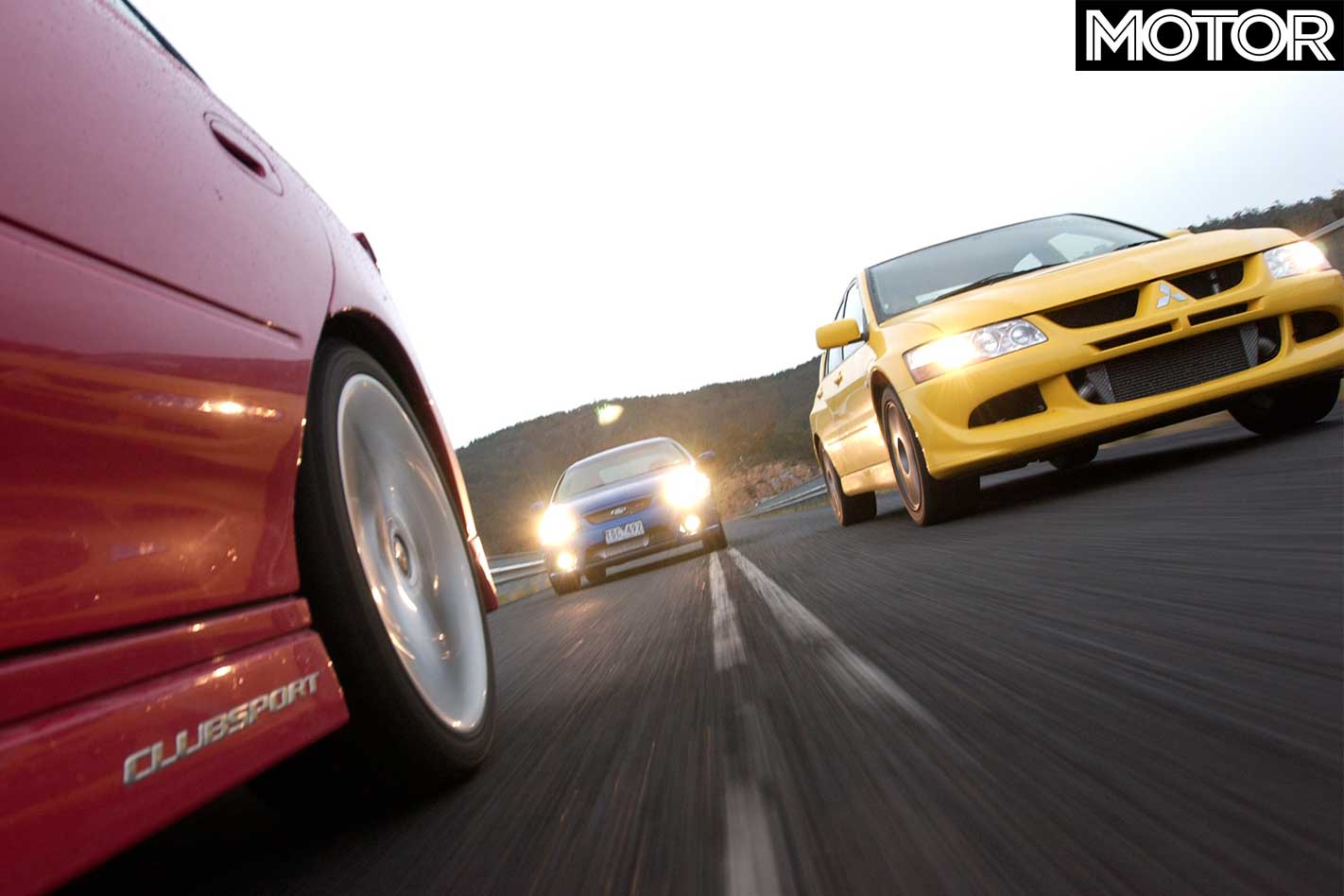
It rolls in corners but it’s also soft enough to soak up bumps. It’s well balanced, tied down with a trace of push on entry, neutral mid-corner and lairy slides on exit if you’re up for it. Its engine gargles its intentions from 2500rpm, growls from three, clears its throat with a kick at four-grand and blasts out to the limiter like rolling thunder. There’s a massive spread of linear shove on tap, and it’s never caught wanting – except for a swifter shifter.
But there are two problems: hit a dip at speed and the suspension bottoms out, sending a nasty thunk through the chassis. The other is the front tyres, which tend to fold under when pushed hard. Blame the chassis, blame the trade-off in good ride, but on the nose-heavy HSV, it will literally scrub the tyre size off the sidewall.
Typhoon goes one better: the ride is similar even though it’s on 18s, the shocks feel firmer, and though the steering isn’t as sharp as the Clubbie, the chassis sure is. It doesn’t roll like the HSV and it works both the front and rear tyres evenly with a sweet balance. It’s more eager to change direction, more responsive to fine inputs and works its suspension more effectively and efficiently.
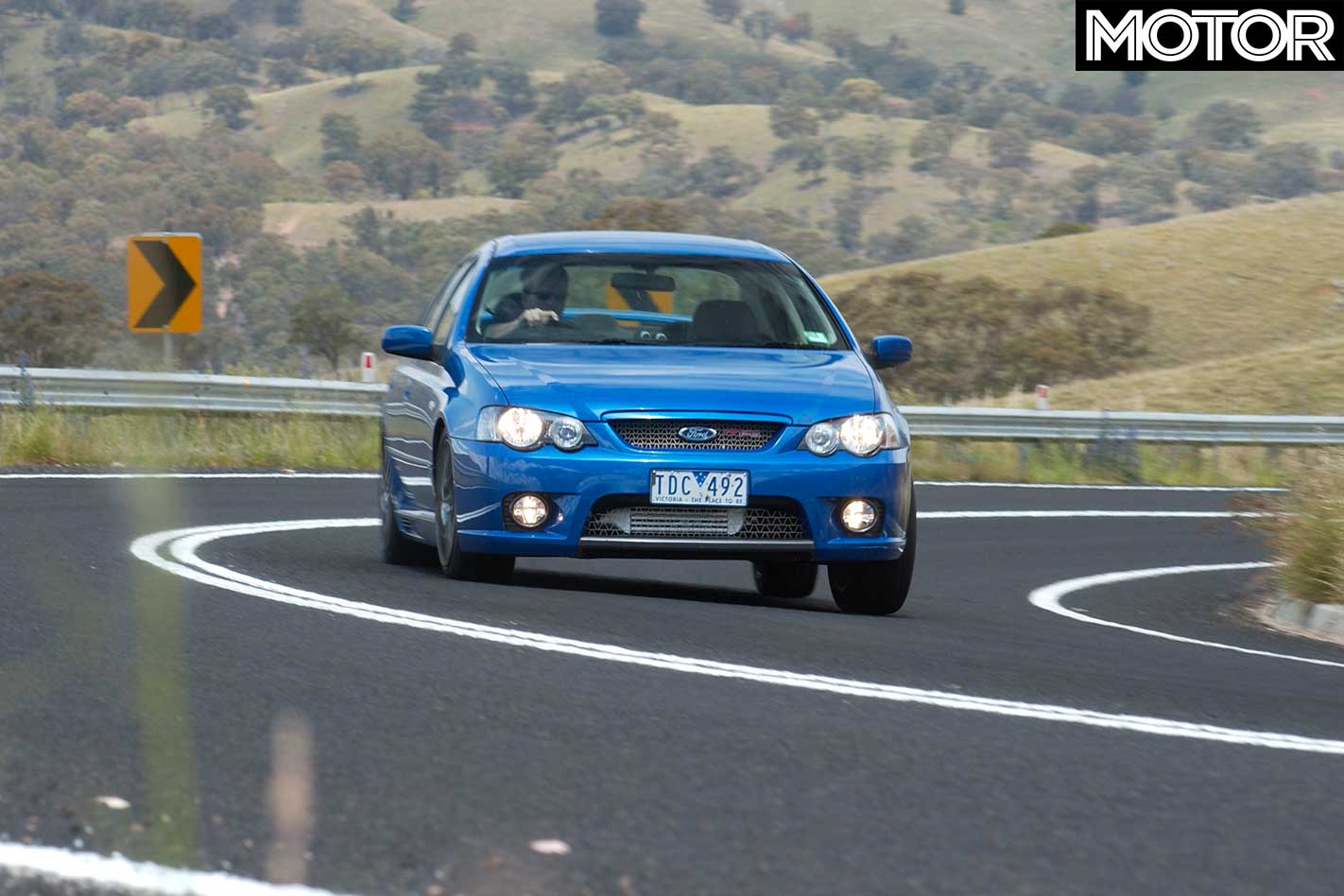
The turbo six has neither the immediate response of the HSV’s V8 nor the turbo lag of the Lancer’s four. Its 4.0-litre grunts from corners while the turbo takes a second to spool. This actually makes the power delivery smoother (and wheelspin a tougher ask) than the instant torque of the HSV.
F6 gets its speed from its mountain of mid-range urge: but too low or too high revs and the F6 is caught out. It’s developing boost from 2000rpm, but it’s not until just under 4000rpm that it winds up like a turbine.
It just doesn’t have the top end of the HSV or EVO. But it doesn’t need to bounce the limiter, either – shift into third at 5500rpm and it drops back to the meat of its torque at 4000rpm. It feels fast, but it’s quieter than the booming V8 or harsh Mitsubishi.
Then the yellow flash looms. Evolution VIII is made for winding roads, and compared to the two Aussies, the VIII is in another world of performance and speed.
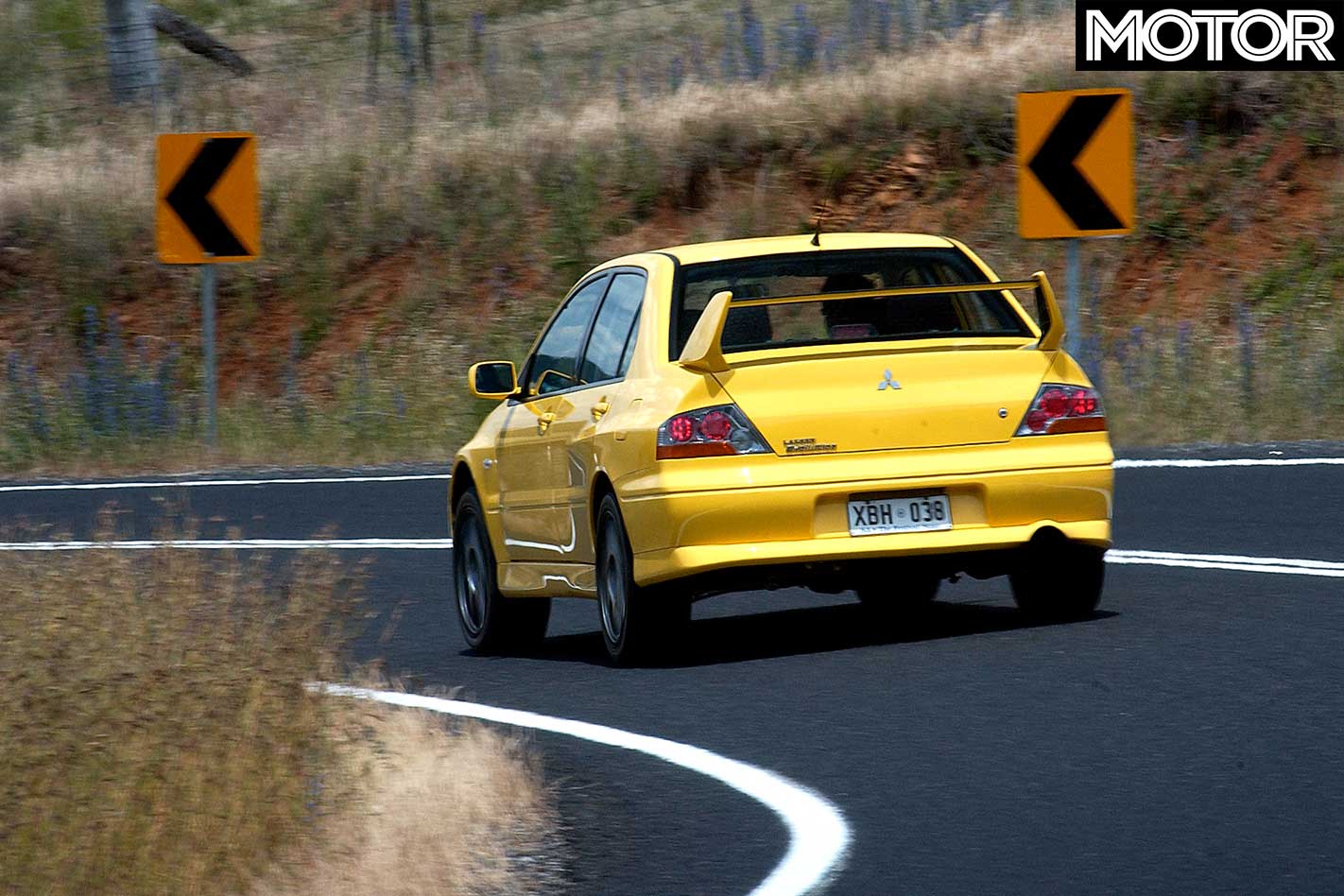
It’s hunkered down, tighter, tauter, frantic and frenetic, like a mongoose on speed looking for a cobra to tease. The steering is the sharpest here by a mile, rarely needing more than a quarter of a turn, and you simply throw it at any corner with the insurance and assurance of the massive traction of all-wheel drive. It’s twitchy and darty but never nervous.
It’ll eat the other two for entrée under brakes. Its chassis is so reactive, it feels like it rear-steers into the corner, with amazing grip like it’s being swung from the apex. Any trace of understeer is banished with the centre diff proportioning drive to the rear with the smallest oversteer drift as it blasts out of the corners.
Bury the pedal a car length earlier than the Aussie cars and it just blasts away, while the slick shifter punches through the gears with the feeling it’s pivoting from a point rather than passing through a gate.
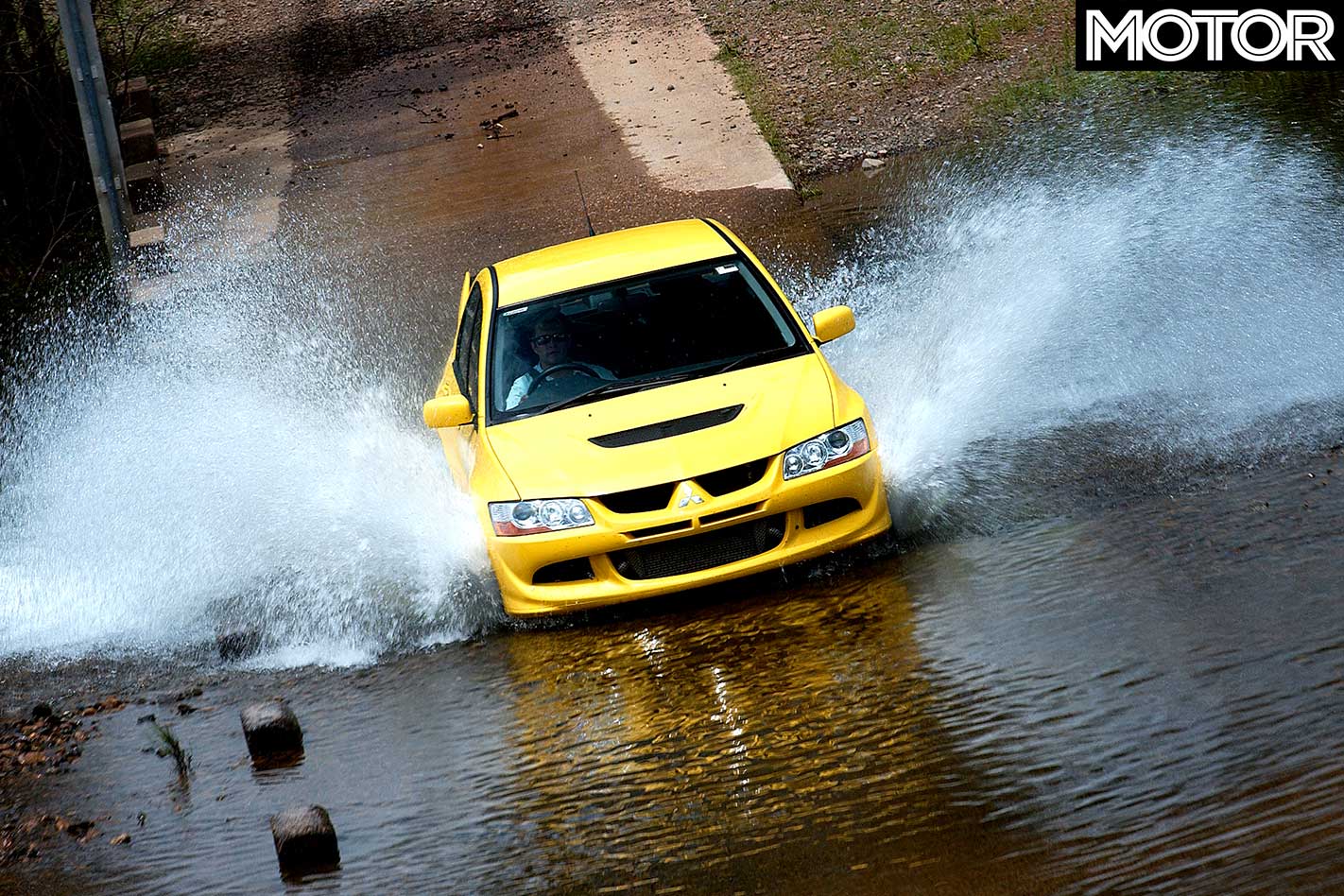
But it’s heavily reliant on its turbo: two-litres of engine isn’t much when you’re against engines with two and three times its capacity and it’s often caught off guard, off-boost and off pace. Under 4000rpm, it’s painfully doughy, a problem the turbo Typhoon overcomes with its two additional litres and cylinders.
But the Lancer’s turbo lag was no big surprise. What did catch us out was its top-end whack. From 4000rpm to the 7600rpm limiter, there’s a fantastic rush of top-end power.
The Lancer’s slower speed than the Clubbie over the quarter-mile needs clarification: our performance times were tested on a 36 degree day. On a cooler 15 degree day for the photo shoot, the result was more favourable to the turbos.
Evolution does feel quicker than the FPV, but it doesn’t feel like it has the HSV’s measure. The fact it does is the most impressive part.
Mountain pass score: Evo VIII – 3 Typhoon – 2 Clubsport – 1
Round 6 – Cruise
When the volume turns down, it’s easier to reflect on the daily viability of each weapon. Though our driving was hard, it’s relative. The Typhoon was the thirstiest, slurping 19.9L/100km. The Lancer was best with 16.5L/100km, but the HSV (17.9L/100km) uses its 75 litre tank to offer the longest range of 420km. In comparison, the Mitsubishi’s 55-litre tank has the fuel light flicking on at a paltry 330km.
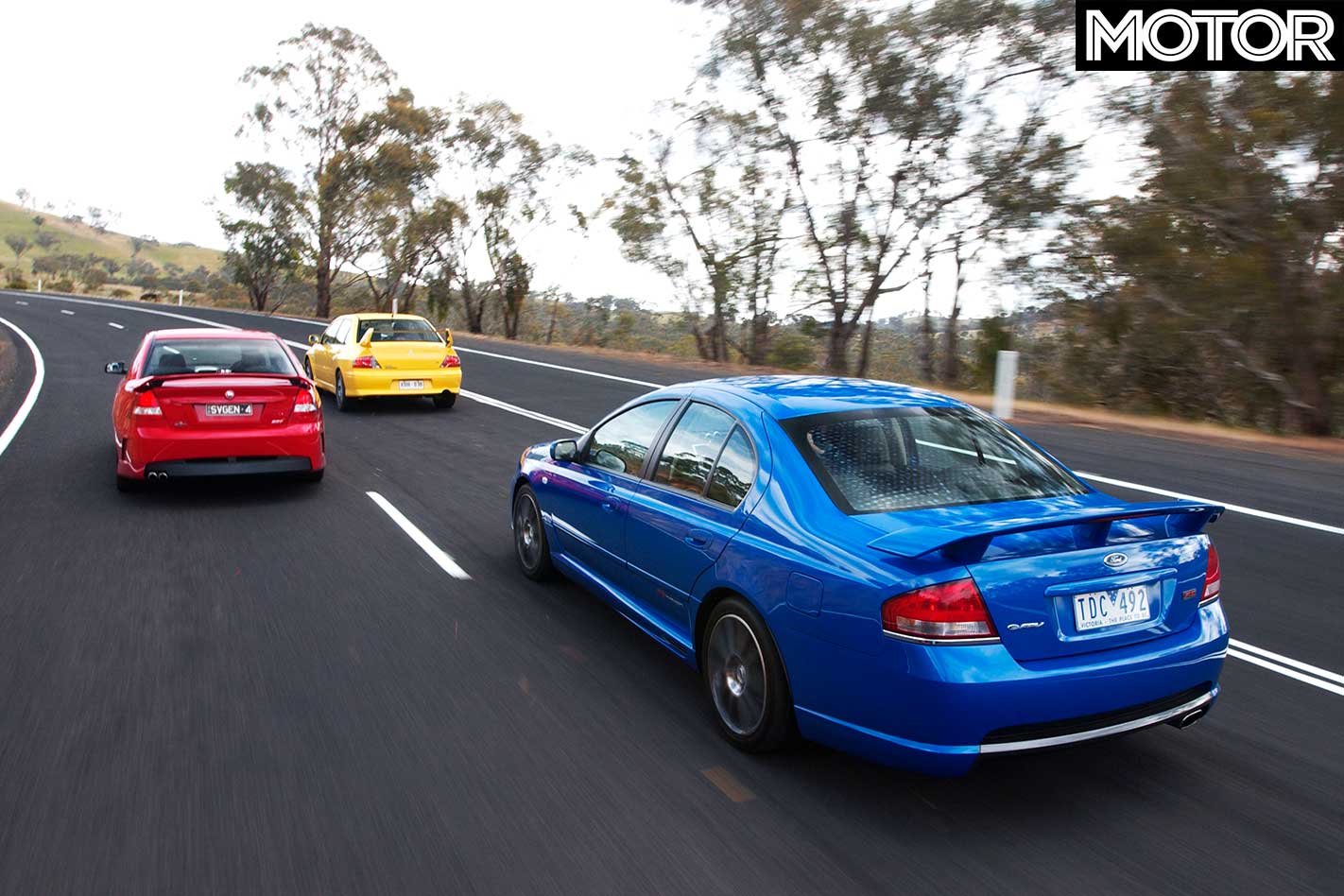
In sixth gear at 100km/h, the HSV’s the cruiser: on just 1600rpm, against Typhoon’s 1950rpm, and the VIII’s 2600rpm in fifth. With the Clubbie’s instant response, for daily comfort, it’s an easy round win.
Road cruiser score: Clubsport – 3 Typhoon – 2 Evo VIII – 1
The scorecard is done. The ClubSport’s 15 points edges out the Evolution VIII’s 14 and Typhoon’s 12. The FPV is very good, but it has more minor issues than the others, and you’re left with the feeling that there’s more potential, and that FPV’s being PC by not making it faster than its own V8 GT.
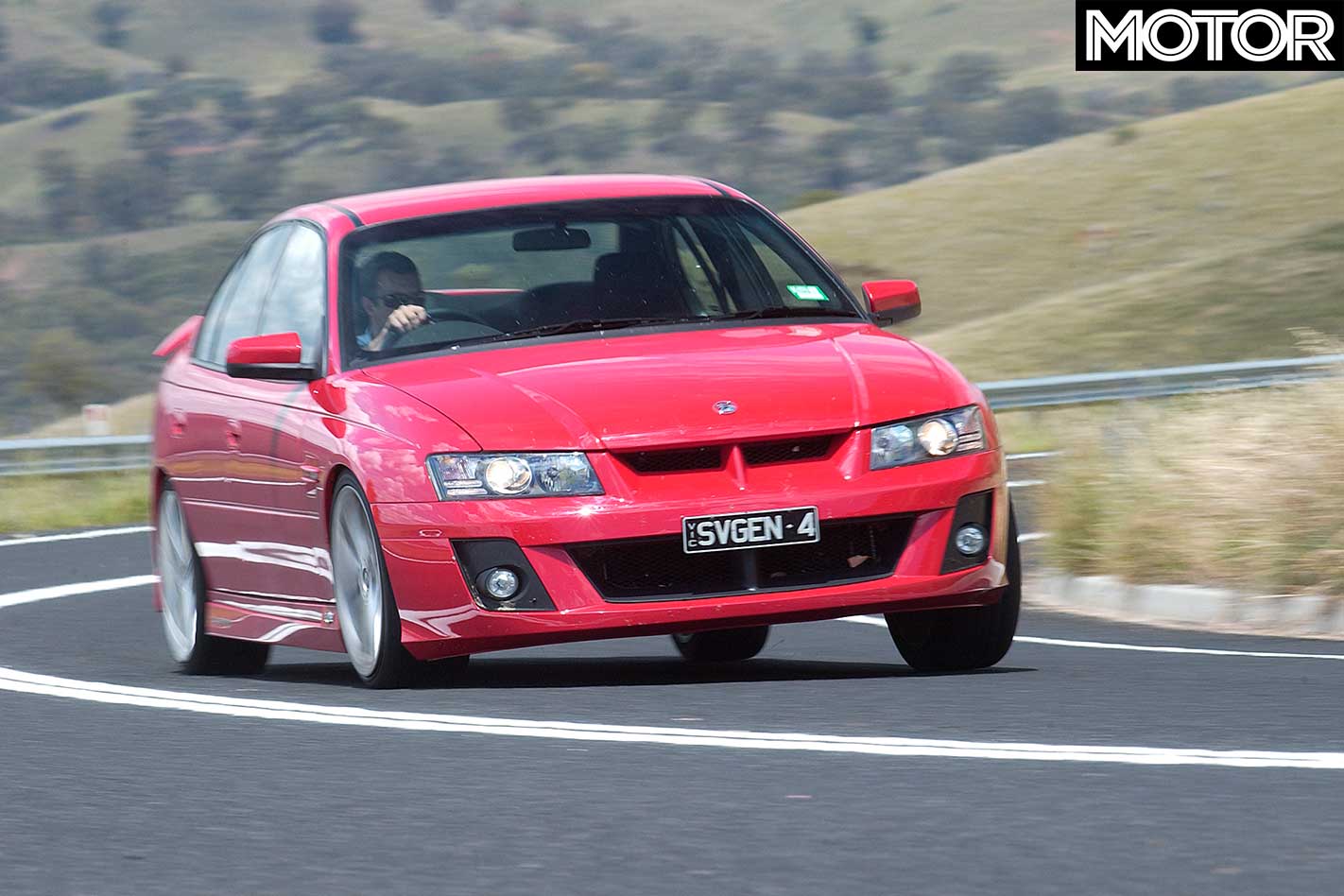
The Lancer is pure speed. That it’s comparable to the 6.0-litre ClubSport, faster in some ways, is proof that two-litres, turbo and technology is a titanic combination. It makes no excuses but it is compromised in equipment and comfort.
Which crowns HSV’s 6.0-litre ClubSport. It feels, sounds and, most of the time, is the fastest. It has all the equipment and comfort of the F6 and the speed of the Evolution. While there are grumbles, they’re minor. The Mitsubishi has its moments, but the ClubSport is always on. When it comes down to forking out 60 grand for a performance sedan, the HSV ClubSport chalks up a win for the V8.
Fast Figures
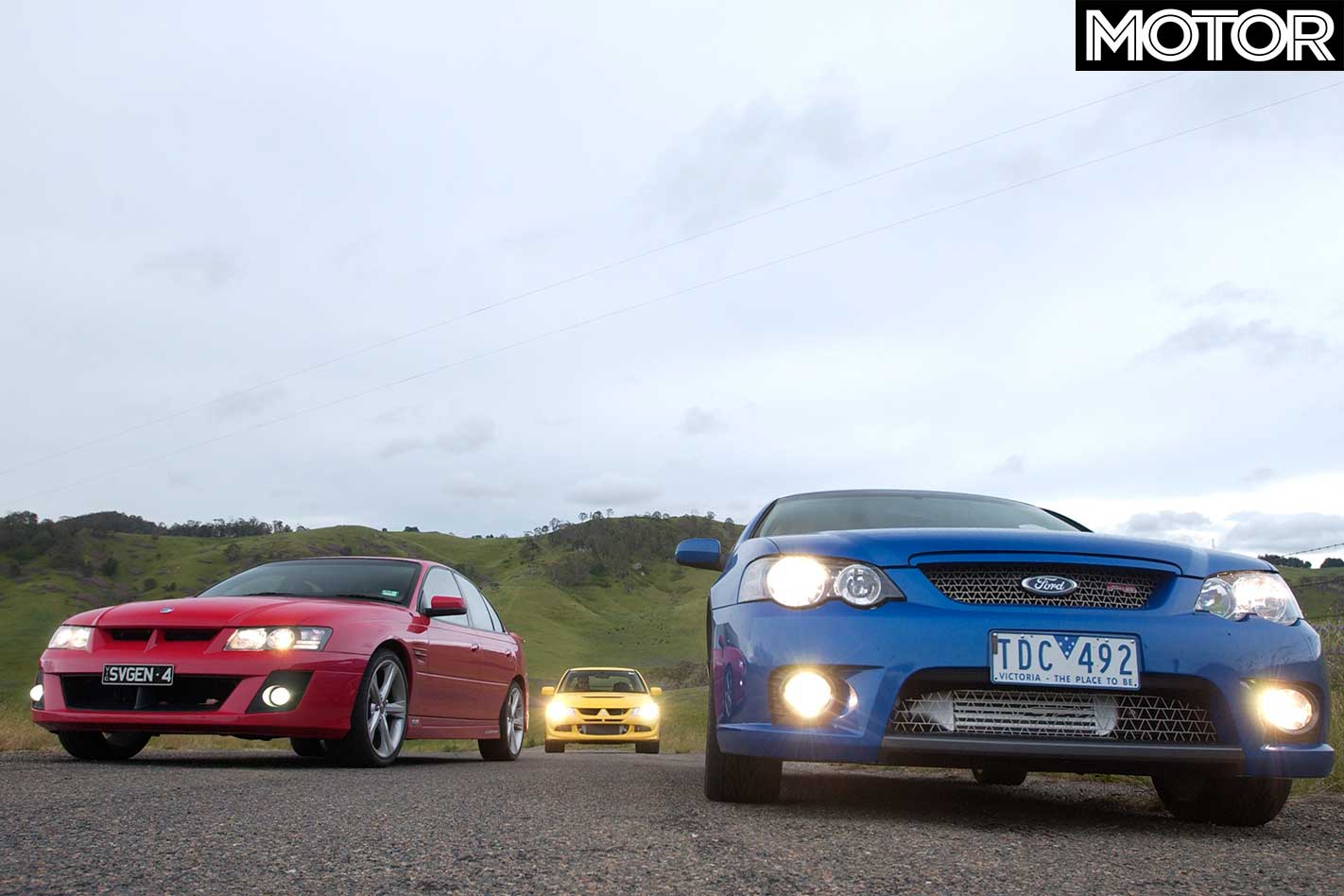
| (km/h)u00a0 | Clubsport | Evo VIII | Typhoon |
| 0-10 | 0.47sec | 0.34sec | 0.55sec |
| 0-20 | 1.02sec | 0.64sec | 1.13sec |
| 0-30 | 1.56sec | 0.94sec | 1.71sec |
| 0-40 | 2.08sec | 1.36sec | 2.25sec |
| 0-50 | 2.58sec | 1.80sec | 2.74sec |
| 0-60 | 3.06sec | 2.31sec | 3.22sec |
| 0-70 | 3.63sec | 3.22sec | 4.10sec |
| 0-80 | 4.52sec | 3.88sec | 4.86sec |
| 0-90 | 5.09sec | 4.59sec | 5.57sec |
| 0-100 | 5.83sec | 5.41sec | 6.40sec |
| 0-110 | 6.73sec | 6.78sec | 7.71sec |
| 0-120 | 7.86sec | 7.76sec | 8.76sec |
| 0-130 | 8.89sec | 8.87sec | 9.90sec |
| 0-400m | 14.01sec @ 169.1km/h | 13.84sec @ 161.2km/h | 14.64sec @ 159.9km/h |
Fast Facts
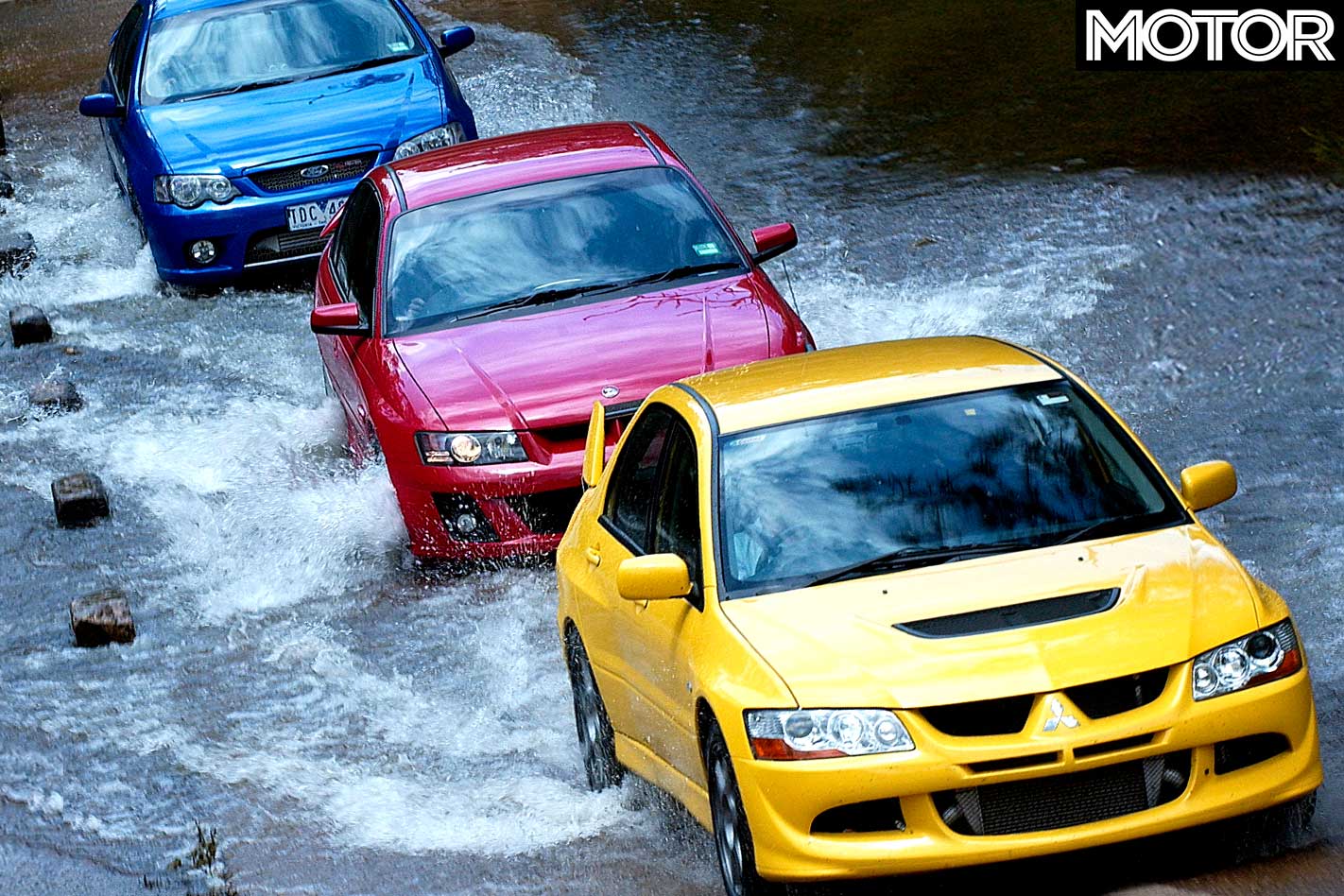
| u00a0 | 2005u00a0HSV Clubsport | 2005 FPV F6 Typhoon | 2005 Mitsubishi Lancer Evolution VIII |
| DRIVE | rear-wheel | rear-wheel | all-wheel |
| ENGINE | front-mounted, 6.0-litre, 16-valve, pushrod V8 | front-mounted 4.0-litre, DOHC 24-valve turbo six | front-mounted 2.0-litre, DOHC, 16-valve, intercooled turbo four |
| BORE/STROKE | 101.6mm x 92.0mm | 92.3mm x 99.3mm | 85.0mm x 88.0mm |
| COMPRESSION | 10.9:1 | 8.7:1 | 8.8:1 |
| POWER | 297kW @ 6000rpm | 270kW @ 5250rpm | 195kW @ 6000rpm |
| TORQUE | 530Nm @ 4400rpm | 550Nm @ 2000-4250rpm | 355Nm @ 3500rpm |
| WEIGHT | 1696kg | 1715kg | 1470kg |
| POWER/WEIGHT | 175kW/tonne | 157kW/tonne | 133kW/tonne |
| TRANSMISSION | 6-speed manual | 6-speed manual | 5-speed manual, ACD, Super AYC |
| SUSPENSION (f) | MacPherson struts, coil springs, anti-roll bar | double wishbones, coil springs, anti-roll bar | MacPherson struts, coil springs, anti-roll bar |
| SUSPENSION (r) | semi-trailing arms, coil springs, anti-roll bar | Control Blade IRS, coil springs, anti-roll bar | multi-link, coil springs, anti-roll bar |
| L/W/H | 4890/1842/1450mm | 4944/1864/1435mm | 4490/1770/1450mm |
| WHEELBASE | 2788mm | 2829mm | 2625mm |
| TRACKS | 1558mm (f); 1574mm (r) | 1560mm (f); 1575mm (r) | 1515mm (f), 1515mm (r) |
| BRAKES (f) | 330mm ventilated & grooved discs, two-piston calipers | 325mm ventilated & grooved discs, two-piston calipers | 323mm ventilated discs, four-piston calipers |
| BRAKES (r) | 315mm ventilated & grooved discs, two-piston calipersu00a0 | 303mm solid discs, single-piston calipers | 305mm ventilated discs, two-piston calipers |
| FUEL | 75 litres, PULP | 68 litres, PULP | 55 litres, PULP |
| WHEELS | 19 x 8.0-inch (f/r) | 18 x 8.0-inchu00a0(f/r) | 17 x 8.0-inchu00a0(f/r) |
| TYRE SIZES | 245/35 ZR19u00a0(f/r) | 245/40 ZR18 (f/r) | 235/45 ZR17u00a0(f/r) |
| TYRE | Pirelli PZero Rosso | Dunlop SP Sport 9000 | Yokohama AVS Sport |
| PRICE | $61,850u00a0 | $58,950 | $61,990 |
| PROS | Brakes; noise; powerband | handling; price | top-end rush; on-limit grip and balance |
| CONS | pedal placement; no door-lock button | pointless boost gauge; irritating starter button | left-hand indicator stalk; bus-like turning circle |
Gone Clubbing Why the ClubSport R8 pack needs one more option
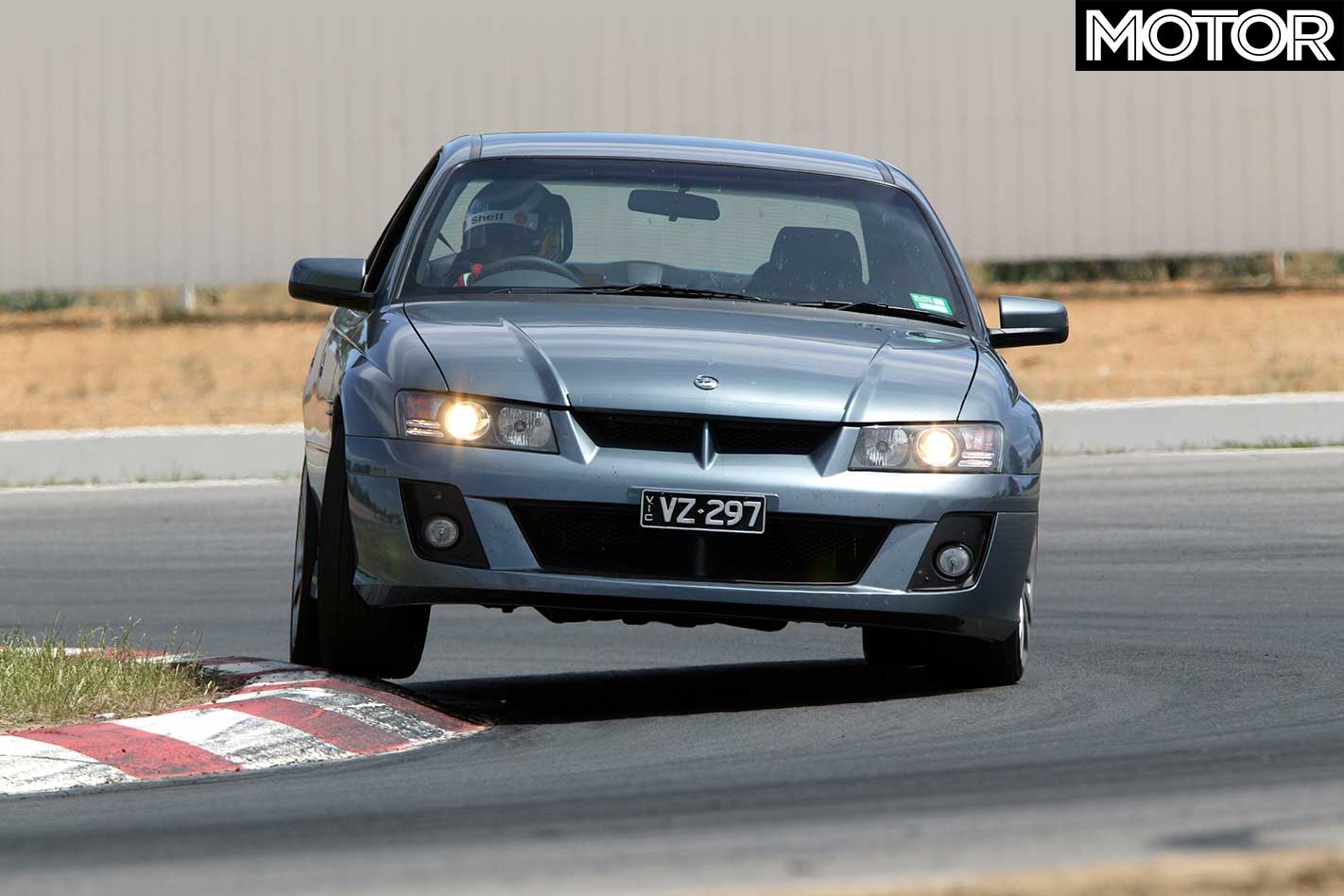
Considering the LS2 6.0-litre ClubSport is just a $1650 increase over the LS1 version, it’s still a great buy. But does it need the R8 pack?
For $70,990, a not inconsiderable increase, the R8 adds leather, gauges, sportier suspension, larger brakes and different design 19s. But what it really needs is grippier tyres.
The 19-inch Pirelli PZero Rossos fitted to the ClubSport are great for the road: they have minimal noise, good ride and wear characteristics. But when pushed hard on the track, their soft sidewalls tend to fold under – to the point where it actually scrubs off the brand and size markings.
A set of R-compound tyres, like Michelin’s track-spec Pilot Sport Cups, would offer the kind of grip and durability a part-time track racer like the ClubSport deserves, and they would be a perfect complement to the existing options list.
Boost an XR6T? Typhoon’s biggest threat comes from Ford’s own XR6T
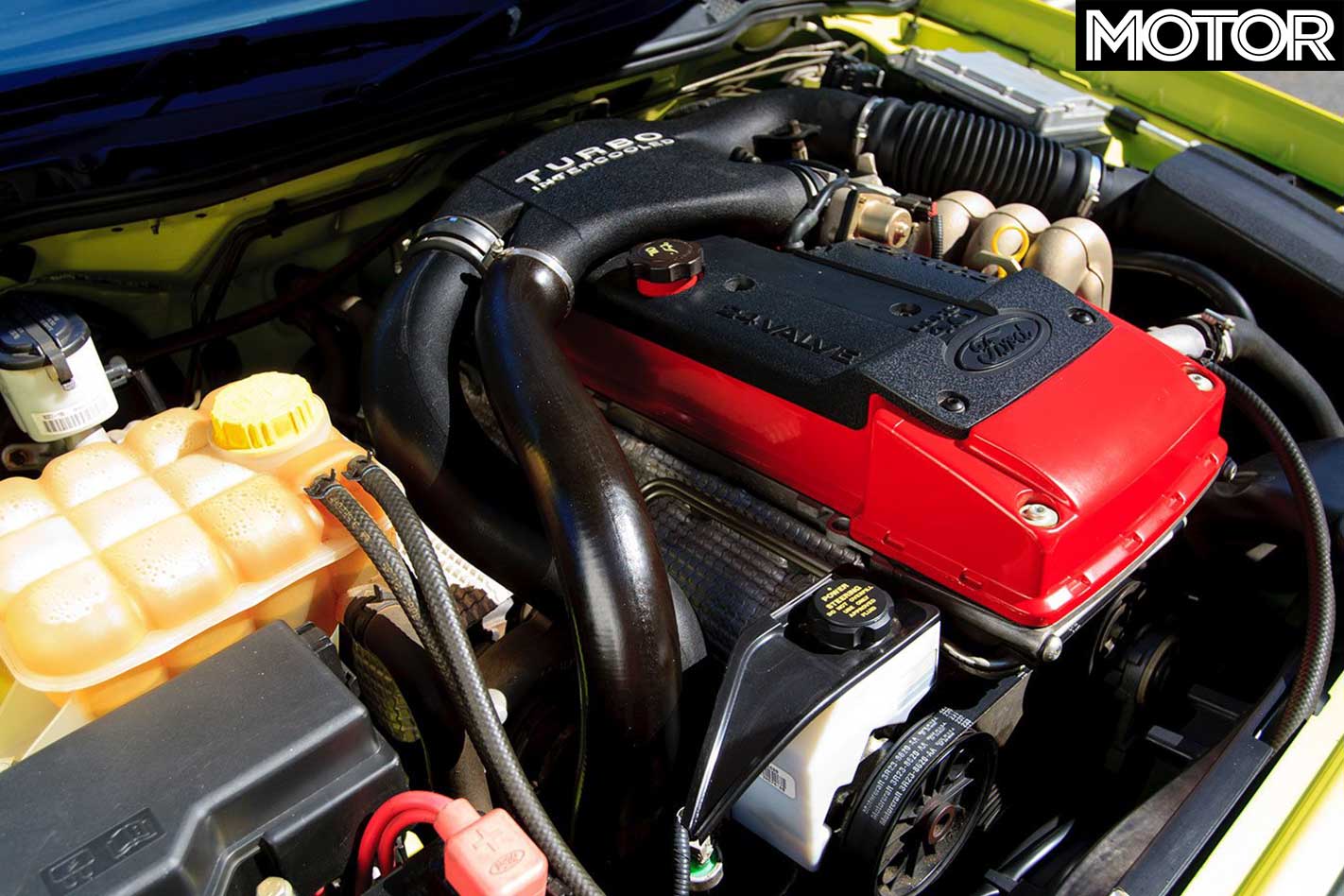
FPV’s Typhoon is $13,385 more expensive than a Ford XR6 Turbo manual, but is it that much better? Keeping in mind our F6 times were done on a hot day, our 0-100km/h of 6.40secs and 0-400m of 14.6@160km/h are still a fair way off our best XR6T times of 5.91 and a 14.1@162km/h.
And the Turbo XR6 is the target of aftermarket tuners keen for even more. The APS Phase 1 kit, for around $2500, drops times down to 5.3 and 13.6@178km/h.
The Phase 2 kit, at $5650, drops it again to 5.2 and 13.3. Yes, there are issues of increased stress, warranty and reliability, but the point is there’s lots more speed to be had.
C&V Performance fitted a Phase 2 kit to its auto XR6T and took it to Western Sydney Dragway. On street tyres, the orange beasty turned in a 0-100km/h in 4.9 and an official quarter-mile of 12.8@178km/h. That’s substantially faster than a Typhoon, $7000 cheaper and shows how much potential is hidden in Ford’s 4.0-litre turbo six.
Fear this Evo! With 302kW, the FQ400 is the God of speed’s gift to Evolution
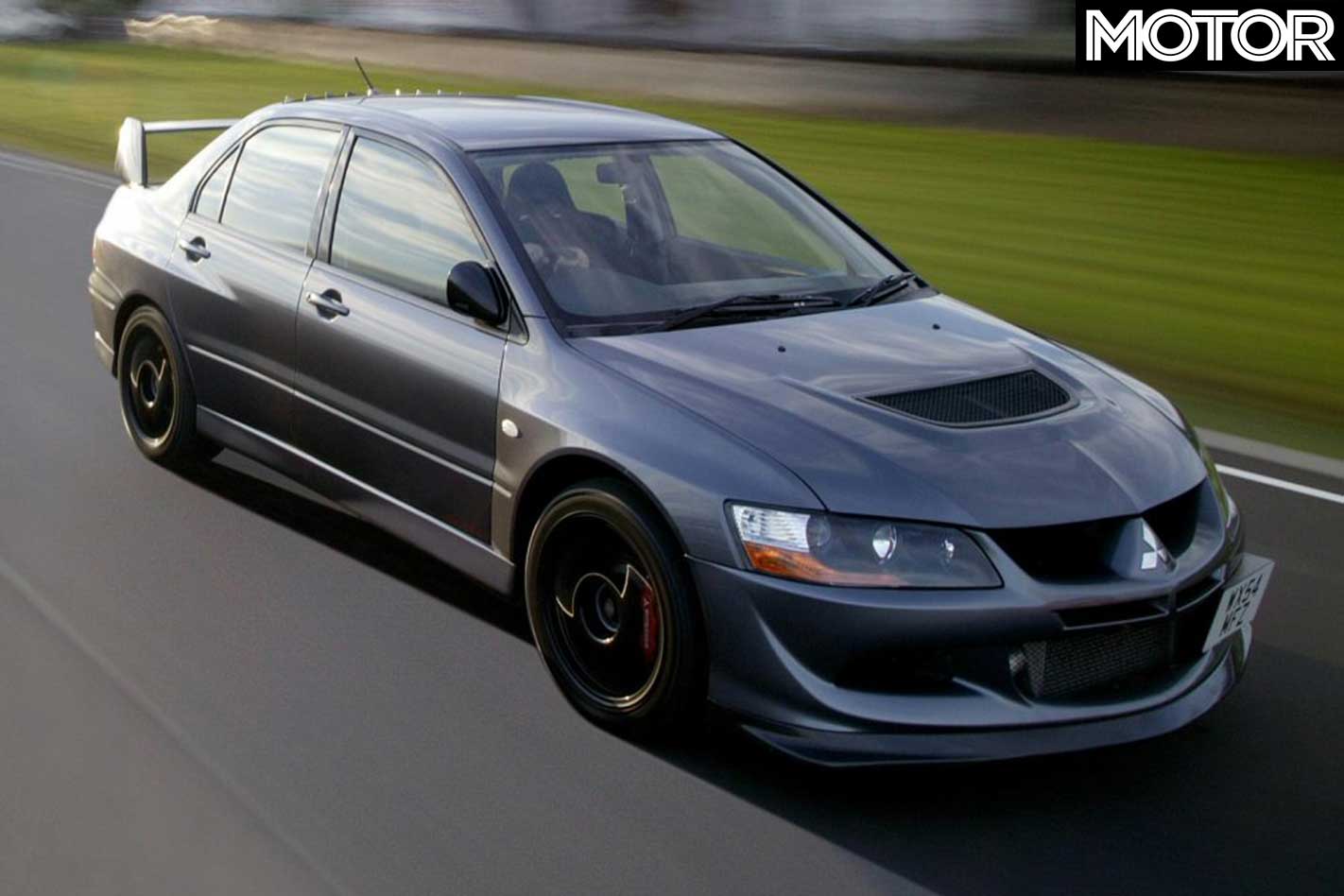
With 302kW, the UK-built Mitsubishi Lancer MR Evolution VIII FQ400 is the fastest car ever released by a volume manufacturer. Zero-to-100km/h arrives in just 3.6 seconds. The 2.0-litre turbo engine runs a larger turbo, stainless exhaust manifold, forged pistons and conrods, metal head gasket and larger injectors, controlled by a MoTeC ECU for a mighty 481Nm.
Underneath is Bilstein suspension and six-piston monobloc calipers on 343mm discs. There’s a PIAA lights and wiper upgrade, carbon fibre chin splitter, Ralliart aero mirrors and shark tooth vortex generators on the rear window. It even comes with a driver training course.
It can be ordered through UK Mitsubishi Ralliart dealers with a three-year/60,000km warranty, but it doesn’t come cheap. Its £45,000UK price converts to around $115,000AUS. Gulp.

